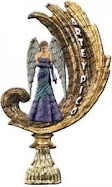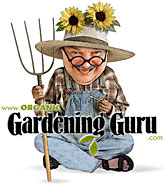A Bit of Background: The book I'm reviewing here is the one I won in the Garden Monkey's horticultural limerick contest last summer. Good enough. The twist (of course there's a twist) was that my limericks roundly abused, and soundly accused, one James Alexander-Sinclair, the author of the book. It was the last shot in the Sock Wars; after winning the contest, I raised a white flag, James sent off the book, and peace has reigned since.
Gardeners’ World Magazine
101 Bold and Beautiful Flowers: Ideas for Year-Round Color
–James Alexander-Sinclair
BBCBooks, 2008
Reading James Alexander-Sinclair’s 101 Bold and Beautiful Flowers is a bit like being spun about a dance floor by an expert, flirtatious partner: it leaves you startled, breathless, and laughing. The images, both visual and verbal, come at you so fast and furious you almost expect to trip up, but no, it all works, you go sailing along at an unbelievable clip, astonished at the felicity and skill that makes it possible.
The only thing seriously wrong with the book is that it confronts the gardener with far too many wonderful flowers to plant, and the reviewer with far too many marvellous passages to cite. The gardener’s problem more or less solves itself, for within the intersection of particular categories of color, height, hardiness, or shade-tolerance, only a few of the many lovely blooms presented will fit the bill. The reviewer faces a more difficult task.
For simplicity, one could start at the beginning (why not?), where James lists things we’d lose without flowers –scent, bees, and “most of all, colour.” He hurries to assure us that, far from living in a flowerless world, “every day of every year some plant somewhere is flowering its little head off”(Intro, 7). (He does not, interestingly, refer to “flowering its socks off,” but enough of that.) This sets the tone, and it’s the tone that makes the book: informed yet informal, urbane yet relaxed. The first flower described, the snapdragon, “resembles the rearing head of a dragon,” he tells us, adding that the opening and closing of its “mouth” produces “not exactly a snap, but more of a toothless chomp”(8). Surely one reads this flower book, rather than some other, largely for the pleasure of being around someone who talks like that.
It’s typical of Alexander-Sinclair that his list of losses in a world without flowers begins with the unexpected item “surprises.” This man who values surprises produces many; he is predictable only in that one can count on his saying something unexpected but apt. Who else would say that morning glory tendrils “stretch and wind like a box of snakes?”(122) Or that the strong midsummer yellow of the Dahlia ‘Clarion,’ following June’s “tasteful pink and baby blue….is like having Little Richard dancing in your border after a month of serenely beautiful Bach cantatas”?(198) The next thing he does is always different from the last one. “Papaverorientale was introduced from Turkey,” he tells us, “and for the first couple of centuries, you could have it in any colour you liked, provided it was orange”(90). And speaking of orange, Tulipa ‘Ballerina’ is so bright, James writes, that “it sends a jolt through the spleen”(38). I’m not sure where my spleen is, or what a jolt through it would feel like, but after reading that, I want to find out.
The book’s subtitle, “Ideas for year-round colour,” hints at a seasonal organization, but in fact the entries are organized by colour itself—fittingly, as this is what the author says may be flowers’ greatest gift to us. Each colour-group, though, offers specimens that will flower early, late, in between, and in a couple of rare cases, all year long, so the judicious reader can indeed assemble a dozen collections that would provide blooms throughout the growing season. The colour categories are more numerous and precise than those found in many wild-flower books at least (these being what I’m most familiar with,) including “Bronze/Brown,” “Magenta,” “Green,” and the unlikely and somewhat unsettling “Black.”
An entire Rex Stout mystery novel revolves around the idea of a truly black orchid and the question of whether such a thing is possible, but here, as there, most “blacks” are actually very dark blues, purples, reds, or even pinks. How they get elevated to “black,” I’m not sure; nor do I understand why they’re separated out in this way. Perhaps it’s to emphasize their sheer darkness. (And perhaps everyone who grows flowers seriously, or even reads about them seriously, knows all about this; it may be a standard designation, for all I know.)
The text proper generally falls into four brief paragraphs that proceed from highly imaginative flights of comparative fancy to hard data. The first section, then, is where you find your competitive similes, those that would win prizes the way ruffled, many-skirted flowers do, for sheer extravagance and daring. This is where James compares a flower to a volcano (22), or to Cyd Charisse’s legs (Agapanthus, p.166) adding, parenthetically, “you will have seen her twirling all over the shop with Gene Kelly in Singing in the Rain, and if you haven’t, you should be ashamed of yourself.” (He’s right about that, by the way.) He introduces a lively orange zinnia (‘Early Wonder’) thusly: “A real hangover cure, it will scour the eyeballs and overwork the cerebral flippers”(40).
Aside from its undeniable entertainment value, the little book, only about six inches by six, holds a wealth of information. In the short entries—most run a hundred and fifty to two hundred words—he comments on flower names, histories, origins, and families; gives hints about soil, shade, and water likes and dislikes, and makes frequent suggestions about planting arrangements.
One learns that the pasque flower “hates its roots being disturbed” (126), (which may explain why mine seems so slow to recover after being dug up by the cat), that many white flowers smell sweetest after sunset (180), that marigolds attract aphid-munching hoverflies (28), that while yarrow can be divided in either spring or autumn, sneezeweed and angel’s fishing rods should be divided only in spring, that—but one could go on forever, which is, frankly, astonishing, since the book is so small and the entries so short. How James also manages to fit in the propagation information with which each entry ends, and the extended, outrageous analogies and whimsical descriptions with which they begin, is a mystery of style and a miracle of conciseness.
Yet there are occasional lapses in style, the more startling from such a deft stylist. Two entries in a row begin with the phrase “Some of you may remember,” (p.126 & 128), and quite a few with “It may seem…” or a close cousin (“This might seem…” or “I know it might seem…”). This is particularly noticeable as most appear in the first half of the book.
Most likely the entries weren’t written in the order in which they appear, so the first problem, at least, can be laid at the feet of the editor, not the author. It’s the editor’s job also to notice and point out the echoes that bothered me.
Perhaps more disturbing, the prose seems to suffer from an occasional outbreak of “is’s” which, like acne, can be excused in an adolescent writer, but in an adult, or established writer, make one suspect bad hygiene (or poor editing.) Perhaps the most densely spotted example can be found in the description of French lavender (Lavandula stoechas ‘Tiara’). The author opens by evoking the lavender we’re all familiar with, and then continues thus:
‘Tiara’ is a slightly less hardy relation. The most obvious difference is the coxcomb of cream-green petals that stick vertically upwards (it is sometimes referred to as ‘Bunny Ears’ lavender). Below these protuberances is a chubby tubular body that is studded with tiny, jewel-like, blue inflorescences that makes (sic) it look like a strange, mythical insect. It is a little shorter than other lavenders….
(164)
Six “is” verbs in four sentences. Odd. Especially as it would be so easy to edit several out:
‘Tiara’ is a slightly less hardy relation. The most obvious difference, the coxcomb of cream-green petals that stick vertically upwards, gives it its nickname, ‘Bunny Ears’ lavender. Below these protuberances is a chubby tubular body studded with tiny, jewel-like, blue inflorescences that make it look like a strange, mythical insect. It doesn’t grow quite as tall as other lavenders….
Only two “is’s” remain in this version, and generally speaking, editing out half the offenders will bring an outbreak of “to be” verbs under control.
Alexander-Sinclair can be charged with his share of literary sins, no doubt, but neither redundancy nor the over-use of “to be” verbs is amongst them. Even his blog posts, which one can assume are written more hastily than were these entries, rarely show this sort of carelessness. So I wonder if some editor’s been messing with his prose. It does happen. Even if James did both write and submit the passage above, his editor should have caught it and handed it back with a hearty “Say, old chap, this doesn’t seem to be quite up to standard, what?” At the very least, I’d say that the book could have been edited a mite more carefully—as the actual grammar error in the selection above shows. (I’m sorry, but I just refuse to believe that James could write “inflorescences that makes…”) and not notice it afterwards.
In such a beautifully crafted little book, it’s a pity that these occasional lapses were allowed to slip by. Fortunately, they are indeed occasional, and the delights far outnumber them.
One of those delights is Alexander-Sinclair’s frequent use of personification. He compares Scabious (Knautia macedonica ‘Crimson Cushion’) to “the perfect boyfriend,…. polite and charming to your mother,…immaculately turned out…unfailingly generous” and so on (18), while Sneezeweed (Helenium ‘Rauctopas’) “is a cheery fellow who saunters onto the scene at the end of June and proceeds to hang around at the back of a fertile border jollying things along…”(46).
Many of these personifications are slightly risqué—“nothing too explicit, but just enough to thrill,” as he says of African Daisy (Arcototis adpressa ‘Haylay’), which reminds him of “that great 1980’s invention, the Ra-Ra skirt”(194). The allium ‘Firmament’ is “sultry,” the tulip, ‘Maytime,’ “coquettish,” while the iris ‘Ecstatic Night’ is “the colour of the curtains in a Circassian bordello”(108). (And how does he know that? Better not to ask.) His chosen peony, (Paeonia lactiflora ‘Sarah Berhardt’) may be hard to grow, but “if you do succeed, you will be rewarded with… a great frothing confection of pink as soft and desirable as a starlet’s cleavage”(70).
These comparisons are so over-the-top, so tongue-in-cheek, that to find them offensive would be to miss the point entirely. How can one work up a lather of indignation at someone who begins one entry (Clematis viticella ‘Madame Julia Correvon’) thusly: “If I had to have a wild and passionate affair with a clematis…” Hello? Whatever else goes on, one has to celebrate the sheer extravagance of the imagination behind that opening. And if that imagination is somewhat “fevered” (a possibility James entertains after describing this flower as “glancing coquettishly over its shoulder with ‘come-to-bed-eyes’”), well, one can only grin and agree.
In many flower books, it’s hard for the prose to live up to the pictures. In this book, the challenge works in the opposite direction. The photographs, taken by a number of photographers, were presumably selected by Janet Johnson, who is credited as Picture Researcher, a round-about process that could create an ad-hoc and haphazard collection. However, they are almost all stunning close-ups with blurred backgrounds, so there’s no sense of visual incoherence. Indeed, the photographs are so universally delectable that they make me wish I were a bee, so I could crawl inside the blossoms and drink them up.
This tiny, colorful volume includes an extraordinary amount of information and will yield an amazing amount of pleasure. Only one thing is missing. In the opening list of things that would be lost in a world without flowers, a critical item has been left out: no flowers would mean no flower book by James Alexander-Sinclair. And that would be a real loss.

 Subscribe to RSS feed
Subscribe to RSS feed



Fantastic Kate! That must be the longest review when judged against the length of the book ;)
Luckily we also get a monthly fix of James’ prose in Gardeners’ World magazine here in the UK.
Thank you, Kate. That is really lovely.
Unlike most people (except, perhaps, my mother) you seem to have read it all. Your stamina – and good taste – is to be applauded.
If anybody else wants a copy of this book then just yell and I’m sure I can help. It is ridiculously reasonably priced and would make an ideal Christmas present.
Thank you, VP. I frequently envy James’ ability to be concise. (Is there a one-word equivalent? Conciseness? Concision? Help!) You see my point.
James, I’m so glad you’re pleased. I’d been wondering if I could get a couple more copies on this side of the water.
I read your whole review. My goodness, it was grand! When I read some of what your write and then some of what James writes–I start googling words and phrases to get a better understanding.
I really had no idea that some of my flowers were more grand than I imagined. Seems like I might need to take out a new insurance policy on my house since my flowers just got some new classy descriptions.
Great review of a great book. I enjoyed both in equal measure.
Thats a great review and I now want to read the book so it will be going on my Xmas list.
.
Anna, do you really have a lot of what’s in James’ book? The actual varieties and cultivars he recommends? That’s amazing! You should do a post on it.
Zoe, thank you. High praise indeed.
Helen, so good to see you here! I’m thinking of hitting James up for a cut on whatever he sells after my review came out. What do you think?
–Kate